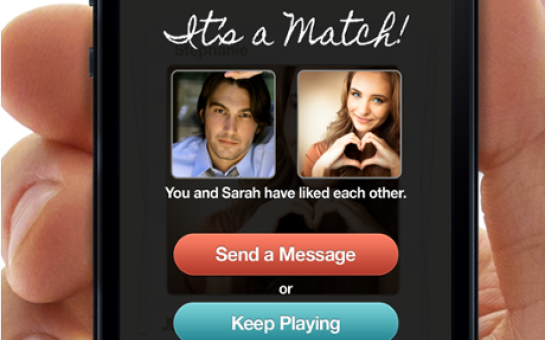Originally launched in the US in August 2012, the smartphone dating app has since spread its blend of location-based profile matches and text-chatting around the world. That includes becoming the latest participation pub-sport in the UK, where groups of friends enthusiastically approve or reject potential matches on behalf of one another.For fans, it’s an addictive cross between online dating, Am I Hot or Not and Fruit Ninja – the latter in terms of its speedy-swiping user interface. Users create a profile, then browse users nearby marking those they like. Whenever they’re liked back, the pair can text-chat and decide whether to meet up.In the last 60 days, Tinder has added more than 1m new users in the UK alone, according to co-founder and chief marketing officer Justin Mateen, who tells The Guardian that the app is currently generating more than 600m profile reads and 6m matches a day.He’s emphatic that Tinder is NOT a “hookup” app, designed to bring people together for casual one-night stands. In fact, he claims dating wasn’t the original motivation behind the app, which is backed by media and internet firm IAC – which also owns online dating firm Match.com.“We never intended it to be a dating platform. It’s a social discovery platform, facilitating an introduction between two people,” says Mateen. “As the product evolves, we’re moving into different uses for it, doing little things that will allow people to interact socially in ways other than dating.”In other words, Tinder is keen not to shut out people already in relationships who aren’t looking for a new partner, although given its firm reputation as a dating app so far, I wonder if simply adding non-dating features will be enough to persuade most couples that it’s acceptable to be on Tinder.But yes, definitely not a hookup app. “It’s in the messaging of the company, but also in the small details: everything we’ve done is intended to make sure it’s not a hookup app,” says Mateen, suggesting that Tinder interaction is more like people sizing one another up in the real world.“You can’t just walk into a coffee shop and say ‘let’s have sex!’. The world doesn’t really work in that way,” he continues. “Our research shows that less than 6% of our users think it’s a hookup app, and early on that number was probably much bigger, so we’ve been working hard.”For now, Tinder is free, although the company will introduce in-app purchases at some point in the future to start making money. Previous dating apps – Flirtomatic for example – have experimented with payments to send virtual gifts, or promote your profile so more people see it.Mateen gives the standard Silicon Valley social-app line on Tinder’s plans: “We have a very clear idea of how we’re going to monetise, but it’s just not the right time yet. It will be in-app purchases when we do, but anything we do around monetisation will only make the user experience better.”Brands may have a role to play in Tinder’s future too. Mateen says the company is constantly having to delete fake profiles created by brands for advertising purposes, although it has also worked with US broadcasters USA Network and Fox on promotions for their respective TV shows Suits and The Mindy Project.“They built Tinder into the show, it was a kind of product placement, so in return we allowed them to create a card,” Mateen says of the latter collaboration.“We spoke to Mindy, she loved the product, and so we said ‘why not?’ – she created a Tinder video that was exclusive. But in the more general sense of how brands and Tinder interact, right now the product isn’t there yet.”For now, Tinder is focusing on its rapid growth, capitalising on what Mateen thinks is an area being neglected by the world’s largest social network, Facebook, which he suggests is still focused on connecting its users with people they know, rather than with likeminded strangers.“We believe the future of social networks is connecting you with people you don’t know,” he says. “As humans we have this innate desire to grow and meet new people and expand our universe. I truly believe Tinder is the first platform that does that effectively.”As it grows, Tinder is experiencing more interest from the mainstream and technology media alike, for positive and negative reasons. Reports about a number of Winter Olympics athletes’ use of Tinder was an unexpected publicity coup, but the revelation that Tinder users’ specific location data could have been exposed last year showed the company has security challenges to overcome.Growing pains? The growth is certainly rapid. “The way we’ve grown is unbelievable: I was reading something that showed it took Twitter 16 quarters before they got to where we are today in terms of user growth,” says Mateen.Twitter launched in July 2006, so 16 quarters later would be the summer of 2010, when according to Twitter’s own IPO filing, it had 40m active users, adding 9m more in the third quarter of that year.Tinder grew so fast by seeding its app with college students in the US, assuming they’d be an influential group because, as Mateen puts it: “as someone who’s younger in high school, you want to be a college kid. And a lot of adults are envious of college kids too”.He adds that Tinder is broadening out now, though. “Early on, over 90% of our user base was aged between 18 and 24. Today, that number is about 51%,” he says. “13-17 year-olds are now over 7%, 25-32 year-olds are about 32%, 35-44 is about 6.5% and the remainder are older than 45.”These new users clearly aren’t being put off by Tinder’s basis in instant judgement where people are swiped aside in quick succession if their main profile photo doesn’t pass muster. It can feel quite brutal as selection processes go.“It’s painfully honest,” is how Mateen prefers to put it, comparing it to the natural human instincts to judge people by first impressions, however unfair that might be.“In the real world, we’re constantly looking at people and judging them by how they look, what they’re wearing at that particular moment, but on Tinder you have your five photos that you curate yourself,” he says.“It’s more descriptive than seeing somebody in real life. People who use Tinder understand that, although some people who don’t might be more hesitant to sign up. As we evolve the product, we hope to change their minds.”(theguardian.com)ANN.Az
Tinder: the 'painfully honest' dating app with wider social ambitions
Business
20:00 | 25.02.2014

Tinder: the 'painfully honest' dating app with wider social ambitions
If you’re a twenty or thirtysomething single person – or if not, if you’ve sat with a group of them in a bar recently – chances are you’ll have encountered Tinder.
Follow us !










